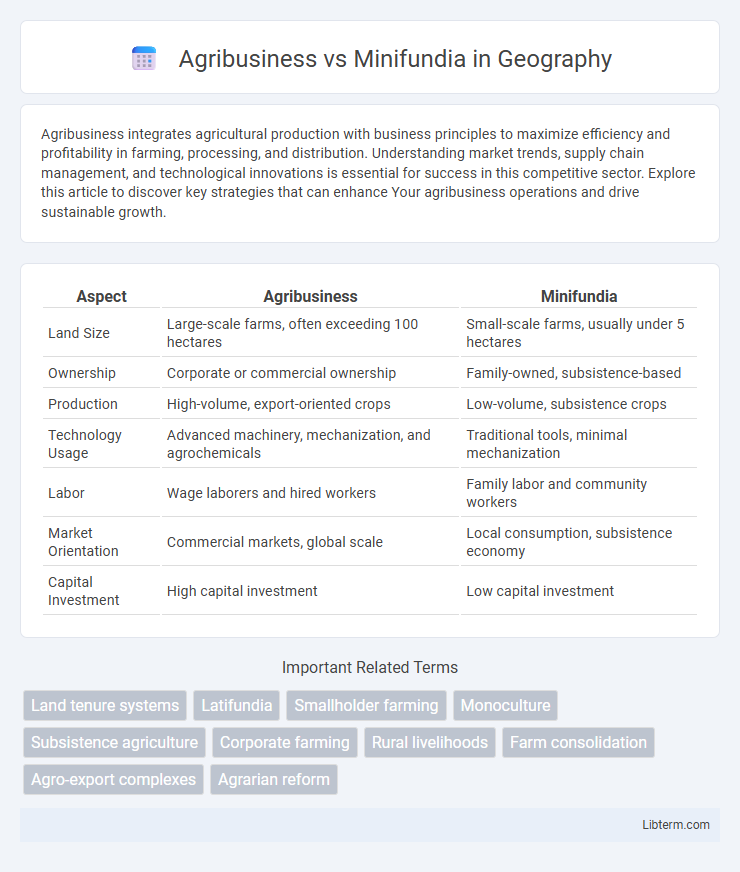Agribusiness integrates agricultural production with business principles to maximize efficiency and profitability in farming, processing, and distribution. Understanding market trends, supply chain management, and technological innovations is essential for success in this competitive sector. Explore this article to discover key strategies that can enhance Your agribusiness operations and drive sustainable growth.
Table of Comparison
| Aspect | Agribusiness | Minifundia |
|---|---|---|
| Land Size | Large-scale farms, often exceeding 100 hectares | Small-scale farms, usually under 5 hectares |
| Ownership | Corporate or commercial ownership | Family-owned, subsistence-based |
| Production | High-volume, export-oriented crops | Low-volume, subsistence crops |
| Technology Usage | Advanced machinery, mechanization, and agrochemicals | Traditional tools, minimal mechanization |
| Labor | Wage laborers and hired workers | Family labor and community workers |
| Market Orientation | Commercial markets, global scale | Local consumption, subsistence economy |
| Capital Investment | High capital investment | Low capital investment |
Understanding Agribusiness: Definition and Scope
Agribusiness encompasses the entire range of activities involved in agricultural production, processing, and distribution, integrating large-scale farming with related industries such as supply chain management, agritech innovations, and marketing. It operates on a commercial scale with significant capital investment, advanced technology adoption, and a focus on maximizing efficiency and profitability across global markets. This contrasts with minifundia, which typically refers to small, fragmented farms oriented towards subsistence or local markets, lacking the extensive integration and scale characteristic of agribusiness.
What are Minifundia? Characteristics and Origins
Minifundia refer to small-scale agricultural plots typically less than five hectares, prevalent in Latin America, characterized by family labor, diverse crop production, and limited access to modern technology. These smallholdings often originate from land fragmentation and historical agrarian reforms that redistributed large estates into subdivided plots for subsistence farming. The essential characteristics include intensive use of land, reliance on traditional farming methods, and vulnerability to economic pressures due to their limited size and resources.
Historical Context: Evolution of Land Use Systems
Agribusiness emerged in the 20th century as industrial-scale farming driven by technological advances and capital investment, transforming traditional land use into large, commercially oriented operations. In contrast, minifundia have roots in colonial Latin America, representing fragmented landholdings that small-scale farmers cultivate primarily for subsistence. The historical evolution reveals a shift from subsistence-oriented, small plots to mechanized, export-driven agribusiness, highlighting socio-economic disparities in land distribution and productivity.
Economic Impact: Agribusiness vs Minifundia
Agribusiness drives large-scale economic growth by integrating advanced technology, increasing productivity, and generating significant export revenues, often supporting global supply chains. Minifundia, characterized by smallholder farms, contributes to local economies through subsistence farming and local market supply but faces limitations in scaling and access to capital. The economic impact of agribusiness surpasses minifundia in terms of employment diversity, income generation, and infrastructure development, although minifundia plays a crucial role in food security and rural livelihoods.
Productivity and Efficiency Comparison
Agribusiness operates on large-scale, employing advanced technologies and mechanization to achieve higher productivity and efficiency per hectare compared to minifundia, which are smallholder farms with limited resources and manual labor. The economies of scale in agribusiness enable better resource allocation, reduced costs, and enhanced output, whereas minifundia often face challenges such as fragmented land, lower capital investment, and inconsistent yields. Productivity metrics indicate that agribusinesses can produce significantly higher crop volumes and generate greater profitability, while minifundia prioritize subsistence farming with lower efficiency.
Environmental Sustainability: Contrasting Approaches
Agribusiness employs large-scale, industrial farming techniques that often lead to significant environmental degradation, including soil erosion, water depletion, and loss of biodiversity due to monoculture practices. Minifundia, characterized by smallholder or subsistence farming, typically use traditional methods that promote crop diversity and sustainable land management, enhancing soil fertility and local ecosystems. While agribusiness prioritizes high yield through mechanization and chemical inputs, minifundia emphasizes ecological balance and long-term environmental health through organic cultivation and mixed cropping systems.
Social Implications: Community and Labor Dynamics
Agribusiness operations often lead to the concentration of land and wealth, marginalizing smallholder farmers and altering traditional community structures, whereas minifundia sustain local economies and preserve social bonds through family-based labor. Large-scale agribusinesses typically rely on hired labor, which can create wage disparities and reduce worker autonomy, while minifundia depend on family labor, fostering intergenerational knowledge transfer and stronger labor rights. The social implications of these contrasting models affect rural development patterns, with agribusiness potentially exacerbating social inequality and minifundia supporting community resilience.
Technological Adoption in Agribusiness and Minifundia
Agribusinesses often leverage advanced technologies such as precision farming, automated machinery, and data analytics to increase productivity and optimize resource use, accelerating sustainable growth. In contrast, minifundia typically face barriers to technological adoption due to limited capital, smaller landholdings, and less access to credit and information. This disparity results in agribusinesses maintaining higher efficiency and output levels compared to minifundia, which mostly rely on traditional farming methods.
Policy and Regulation: Government Influence
Government influence in agribusiness often involves large-scale policy frameworks promoting export incentives, subsidies, and technological advancements to enhance productivity and global competitiveness. In contrast, minifundia face regulatory challenges including limited access to formal credit, scarce land tenure security, and minimal policy support, restricting their growth and sustainability. Policy reforms targeting inclusive land rights, tailored financial services, and technical assistance are critical to balancing government influence between agribusiness and minifundia sectors.
Future Trends: The Path Forward for Global Agriculture
Agribusiness is rapidly adopting advanced technologies such as precision farming, AI-driven analytics, and sustainable practices to enhance productivity and meet global food demand. Minifundia, characterized by small-scale family farms, are increasingly integrating agroecology and community-based models to improve resilience and local food security. Future trends indicate a blend of high-tech agribusiness innovations and resilient minifundia practices will drive sustainable growth and equitable development in global agriculture.
Agribusiness Infographic

 libterm.com
libterm.com